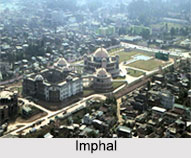 Capital Cities of North East India are Agartala of Tripura, Aizwal of Mizoram, Imphal of Manipur, Itanagar of Arunachal Pradesh, Shillong of Meghalaya and Dispur of Assam. These north east states in India are known as the "Seven Sisters". The states of north eastern India cover an area of 255,511 square kilometers, or about seven percent of India`s total area. The states of north eastern India have a population of 44.98 million, which is about 3.7 percent of India`s total. The north east India has a bouquet of national parks like Namdapha National Park, Kaziranga National Park, Orang National Park, Manas National Park, Dibru-Saikhowa National Park and Biosphere Reserve, Nameri National Park, Balphakram National Park, Nokrek National Park, Mouling National Park, Keibul Lamjao National Park, Sirohi National Park, Murlen National Park, Neora Valley National Park and Ntangki National Park. Out of these, there are many natural vegetation areas, biosphere reserves and hill stations.
Capital Cities of North East India are Agartala of Tripura, Aizwal of Mizoram, Imphal of Manipur, Itanagar of Arunachal Pradesh, Shillong of Meghalaya and Dispur of Assam. These north east states in India are known as the "Seven Sisters". The states of north eastern India cover an area of 255,511 square kilometers, or about seven percent of India`s total area. The states of north eastern India have a population of 44.98 million, which is about 3.7 percent of India`s total. The north east India has a bouquet of national parks like Namdapha National Park, Kaziranga National Park, Orang National Park, Manas National Park, Dibru-Saikhowa National Park and Biosphere Reserve, Nameri National Park, Balphakram National Park, Nokrek National Park, Mouling National Park, Keibul Lamjao National Park, Sirohi National Park, Murlen National Park, Neora Valley National Park and Ntangki National Park. Out of these, there are many natural vegetation areas, biosphere reserves and hill stations.
Agartala
 Agartala is capital of Tripura. It is located on the bank of the Haora River and is geographically 2 km from the Bangladesh border. Agartala is India`s third international internet gateway after the ones in Mumbai in Maharashtra and Chennai in Tamil Nadu.
Agartala is capital of Tripura. It is located on the bank of the Haora River and is geographically 2 km from the Bangladesh border. Agartala is India`s third international internet gateway after the ones in Mumbai in Maharashtra and Chennai in Tamil Nadu.
Aizawl
It is one of the scenic capitals of India; Aizwal has hill stations, biosphere reserves and rivers. Aizawl is located at 3715 feet from the sea level, and is a religious and cultural center of the Mizo Tribes.
Imphal
Imphal is a tiny capital of Manipur with comfortable temperature throughout the year, has the cultural heritage along with the tourist opportunities. This city has the number of Hindu temples that follows Vaishnava cult.
Itanagar
A place of beauty, hill stations, national parks, rivers, and the rich mixture of archaeological sites that belong to Jitari Dynasty. Prominent sites are Itafort, Geykar Sinyik, Jawaharlal Nehru Museum, Craft Centre & Emporium, Zoological Park of Chimpu, Indira Gandhi Park and Polo Park.
Shillong
Shillong is the capital and hill station of Meghalaya with the highest point being Shillong Peak at 6,449 feet, which is one of the most alluring tourist destinations. Shillong has steadily grown in size since it was made the civil station of the Khasi and Jaintia Hills in 1864 by the British Government in India.
Dispur
Dispur, alocality of Guwahati, became the capital city of Assam in 1973. Dispur is also known for the Guwahati Tea Auction Centre. A large variety of tea is auctioned here. Dispur has Shilpagram, Basistha Ashram and Srimanta Sankaradeva Kalakshetra as the tourist destinations with the shopping centers, where mekhla is abundant.



















